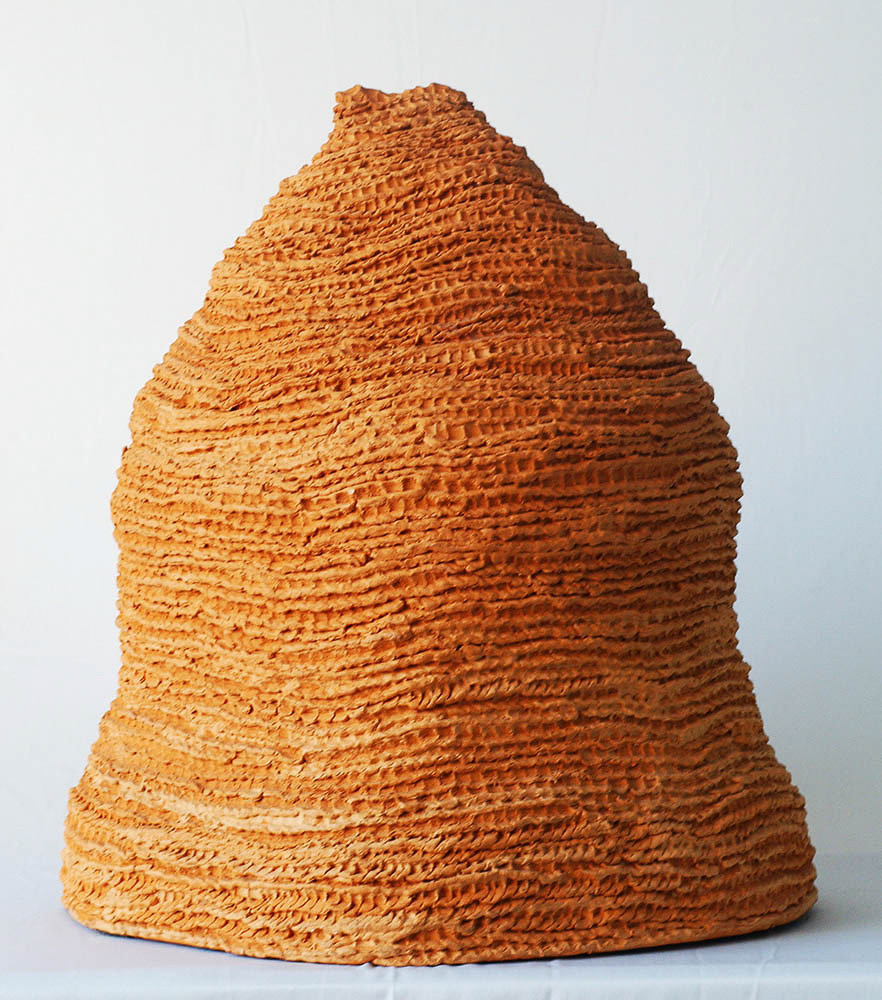Lidia Lisbôa creates her cupinzeiros (termite mounds) as a way to stay in touch with her childhood home.
The termite mounds have some relation to my childhood. I always wanted, when I was a child, to touch the surface of a termite mound because there were many of them in the city where I grew up, in Paraná (Brazil). But my mother never let me touch or play with those termite mounds. She always said it was dangerous. It wasn’t for playing. So, when I started my art and ceramic studies, I decided to touch what I couldn’t when I was a child, and then I created my own termite mounds.
I create the forms of my cupinzeiros inspired by the forms I saw in the real mounds. They are mainly located in Guaíra, Paraná.
I use my fingers to mark each detail of my cupinzeiros. It’s therapeutic work for me. They are then fired in my studio.
I exhibited the cupinzeiros at Galeria Espaço Caixa Branca, at Galeria Rabieh and recently at HOA Galeria. The spectators always love to experience them because the termite mounds are very common in our rural roads in Brazil and people make these relations and seem to access their affective memories. Vestidos & Cupinzeiros (Dresses & Termite mounds) combined these ceramics objects with my textile art. It was promoted by Kite Tecidos, a fabric’s industry.
I think that mainly during these times, as an artist I must create and transmit a colour, an experience, a joy, and provoke reflection in people’s mind, maybe giving them some sort of hope.
Artist
 Born in 1970 in Paraná (Brazil), Lidia Lisbôa is a São Paulo based artist whose work blurs boundaries between object, performance and ritual. While trained in printmaking, sculpture and painting, performance is central to Lisbôa. From performance emerge her various languages: sewing, crocheting, mooring or assemblage of textiles (for the most part) or found/discarded materials. In this process, the created object closes the circle, inspiring the artist to enact a new performance or performative action. Lisbôa’s practice allows us to glance, within the production of black woman artists in Brazil, a possible transition from the art object to performance as formal artistic strategy and feminist tactic. Drawing from her own autobiographical history as well as the biographies of the women in her family, Lisbôa weaves and sculps as to undo the marks of violence endured by black women, while surfacing sentiments and expressions of life and beauty daily forced into concealment and forgetfulness. You can follow her @lidia_lisboa or watch her vimeo.com/lidialisboa.
Born in 1970 in Paraná (Brazil), Lidia Lisbôa is a São Paulo based artist whose work blurs boundaries between object, performance and ritual. While trained in printmaking, sculpture and painting, performance is central to Lisbôa. From performance emerge her various languages: sewing, crocheting, mooring or assemblage of textiles (for the most part) or found/discarded materials. In this process, the created object closes the circle, inspiring the artist to enact a new performance or performative action. Lisbôa’s practice allows us to glance, within the production of black woman artists in Brazil, a possible transition from the art object to performance as formal artistic strategy and feminist tactic. Drawing from her own autobiographical history as well as the biographies of the women in her family, Lisbôa weaves and sculps as to undo the marks of violence endured by black women, while surfacing sentiments and expressions of life and beauty daily forced into concealment and forgetfulness. You can follow her @lidia_lisboa or watch her vimeo.com/lidialisboa.



